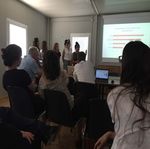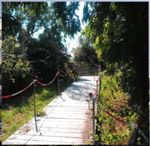Summer School Pellestrina - Consorzio Venezia Nuova
←
→
Trascrizione del contenuto della pagina
Se il tuo browser non visualizza correttamente la pagina, ti preghiamo di leggere il contenuto della pagina quaggiù
Il Provveditorato per le Opere Pubbliche del Triveneto (Ministero delle infrastrutture e dei Trasporti) e il Consorzio Venezia Nuova insieme all’Università IUAV di Venezia e al Massachusetts Institute of Technology – MIT hanno dato vita a una Summer School, che quest’anno è giunta alla seconda edizione. Sede della scuola è stata l’area di cantiere per la costruzione delle barriere di difesa dalle acque alte del Mose alla bocca di porto di Malamocco e il villaggio operai accessorio, situato sull’isola di Pellestrina. L’iniziativa è in linea con la volontà del Provveditorato di diffondere le conoscenze tecnico scientifiche legate al Mose anche attraverso il dialogo e lo scambio con le Università e il territorio. Due sono i principali elementi da cui si è partiti: il primo importante traguardo da raggiungere è quello di rafforzare il ruolo del Mose quale volano di know how, poiché si tratta di un’opera che ha prodotto un patrimonio multidisciplinare, che deve essere raccolto e trasmesso. Il secondo, riguarda le aree di cantiere che, nate come siti di lavoro temporanei, possono essere utilizzate anche come luoghi di studio, analisi e progettazione. Il Mose chiama a confronto due importanti scuole, una di Venezia e l’altra di oltreoceano. Questa è proprio la sua caratteristica: un’opera che ha messo in campo moltissime conoscenze e ha prodotto diversificate esperienze, un laboratorio multidisciplinare, che parte da Venezia, poiché è il territorio che è chiamato a difendere, ma che coinvolge la comunità tecnico-scientifica mondiale. Protagonisti della Scuola sono i luoghi che la ospitano, che sono oggetto di analisi e riflessione per pensarli con destinazioni, trasformazioni, usi e riusi a servizio dell’Isola. The Provveditorato per le Opere Pubbliche del Triveneto e il Consorzio Venezia Nuova together with the Università IUAV di Venezia e the Massachusetts Institute of Technology – MIT have created a Summer School that this year has come to second edition. The site of the school was the area of the worksite for the construction of defense barriers from the high waters of the Mose at the Malamocco inlet and the accessory workers village, located on the island of Pellestrina. The initiative is in line with the will of the Provveditorato to spread the technical scientific knowledge related to the Mose also through exchange with the Universities and the territory. There are two main : the first important goal to be achieved is to strengthen the role of Mose as a flywheel of know-how, as it is a work that has produced a multidisciplinary heritage, which must be collected and transmitted. The second concerns the construction sites, born as temporary work sites, but which can also be used as places of study, analysis and planning. The Mose calls for comparison two important schools, one from Venice and the other from overseas. This is precisely its characteristic: a work that has put in place a lot of knowledge and has produced diversified experiences, a multidisciplinary laboratory, which starts from Venice, because it is the territory that is called to defend, but which involves the international scientific community. The protagonists of the School are the places that host it, which are at the same time the object of analysis and reflection to think of them with destinations, transformations, uses and reuses in the service of the Island.
Docenti e studenti dei due Atenei hanno lavorato insieme alternando lezioni in aula e laboratori in cui gli studenti si sono confrontati in gruppi trasversali. La Scuola, della durata di due settimane si è svolta proprio all’interno del villaggio operai di Pellestrina e si è articolata in lezioni in aula, in momenti di workshop e indagini sul campo. Gli studenti sono stati divisi in tre gruppi di lavoro misti (studenti IUAV e MIT) confermando il carattere di interdisciplinarietà dell’iniziativa: architettura, pianificazione del territorio, ingegneria e studio dei fenomeni legati all’innalzamento del mare. Il Piano di difesa costiera e ambientale di Venezia e della sua laguna «Sistema Mose» è stato presentato agli studenti nella sua totalità, anche approfondendone tematiche specifiche attraverso incontri con tecnici e visite ai cantieri. Teachers and students of the two universities worked together alternating lectures in the classroom and workshops where the students were confronted in cross-cutting groups. The School, which lasted two weeks, took place inside the workers' village of Pellestrina and was divided into classroom lectures, workshops and field surveys. The students were divided into three mixed work groups (IUAV and MIT students), confirming the interdisciplinary character of the initiative: architecture, spatial planning, engineering and the study of phenomena related to sea rise. The coastal and environmental defense plan of Venice and its lagoon "Sistema Mose" was presented to the students as a whole, also deepening specific issues through meetings with technicians and site visits. SUMMER SCHOOL PELLESTRINA «Reinventing Places Venice/Mose. A study on a temporary site between the lagoon and the sea» 1° edtion 29 May – 9 June 2017 SUMMER SCHOOL PELLESTRINA «Marginal territories, but not marginal. The case of the island of Pellestrina» 2° edition 11 – 22 June 2018
I LUOGHI/ THE VENUES La bocca di porto di Malamocco. A destra il rilevato provvisorio che è stato utilizzato come area di cantiere. Qui sono stati costruiti gli elementi prefabbricati in calcestruzzo armato i cosiddetti «cassoni», che sono stati affondati nel canale della bocca di porto a formare la base della barriera di difesa. All’interno dei cassoni, dove sono alloggiati gli elementi mobili delle barriere «le paratoie modulari a scomparsa», sono presenti tunnel percorribili da una sponda all’altra della bocca di porto. Dagli edifici presenti sulle spalle, attraverso i tunnel gli impianti per il loro funzionamento arrivano all’interno delle paratoie. In seguito l’area è stata utilizzata come area di stoccaggio e assemblaggio delle paratoie, prima della loro installazione. The Malamocco inlet. On the right the temporary construction site. Here the prefabricated concrete elements the so-called "caissons" were built, which were sunk into the inlet channel bed to form the base of the defense barriers. Inside the caissons, where the mobile elements of the "modular sluice gates" are housed, there are tunnels that can be traveled from one side of the inlet to the other. From the buildings on the shoulders, through the tunnels the systems for their operation arrive inside the gates. Subsequently the area was used as storage and assembly area of the gates before their installation.
I LUOGHI / THE VENUES Il villaggio operai. Sullo sfondo, un’immagine del cantiere durante la costruzione dei cassoni. In primo piano, il villaggio che ha ospitato 20 studenti, tutor e docenti per due settimane. Nell’area del villaggio si trovano gli alloggi e la mensa, che è stata utilizzata anche come area di lavoro per i gruppi. Mentre la lezioni si tenevano all’interno del cantiere. The village workers. In the background, an image of the construction site during the construction of the caissons. In the foreground, the village that hosted 20 students, tutors and teachers for two weeks. In the area of the village are the lodgings and the canteen, which was also used as a working area for groups. While the lessons were held inside the building site.
I WORKSHOP Workshop purpose Raccogliere un gruppo multidisciplinare e internazionale di studenti, ricercatori e accademici da esplorare possibilità di utilizzo dell'isola e del cantiere provvisorio del Mose a Bocca di Malamocco e sull'isola di Pellestrina compatibile con le esigenze e gli obiettivi della comunità. Gather a multi-disciplinary, international group of students, researchers and academics to explore future possibilities for the use of the island and of the temporary Mose Construction Site at Bocca di Malamocco Sud on the island of Pellestrina compatible with community needs and goals. Topics addressed 1° Edition 2017 An Island and its inhabitants: partecipatory Planning in Pellestrina Venice: Physical and cultural threats of the city Statistical and spatial analysis of flood risk in the Venice lagoon 2° Edition 2018 Food and Agriculture Energy and Water Scientific Tourism
Puoi anche leggere



























































